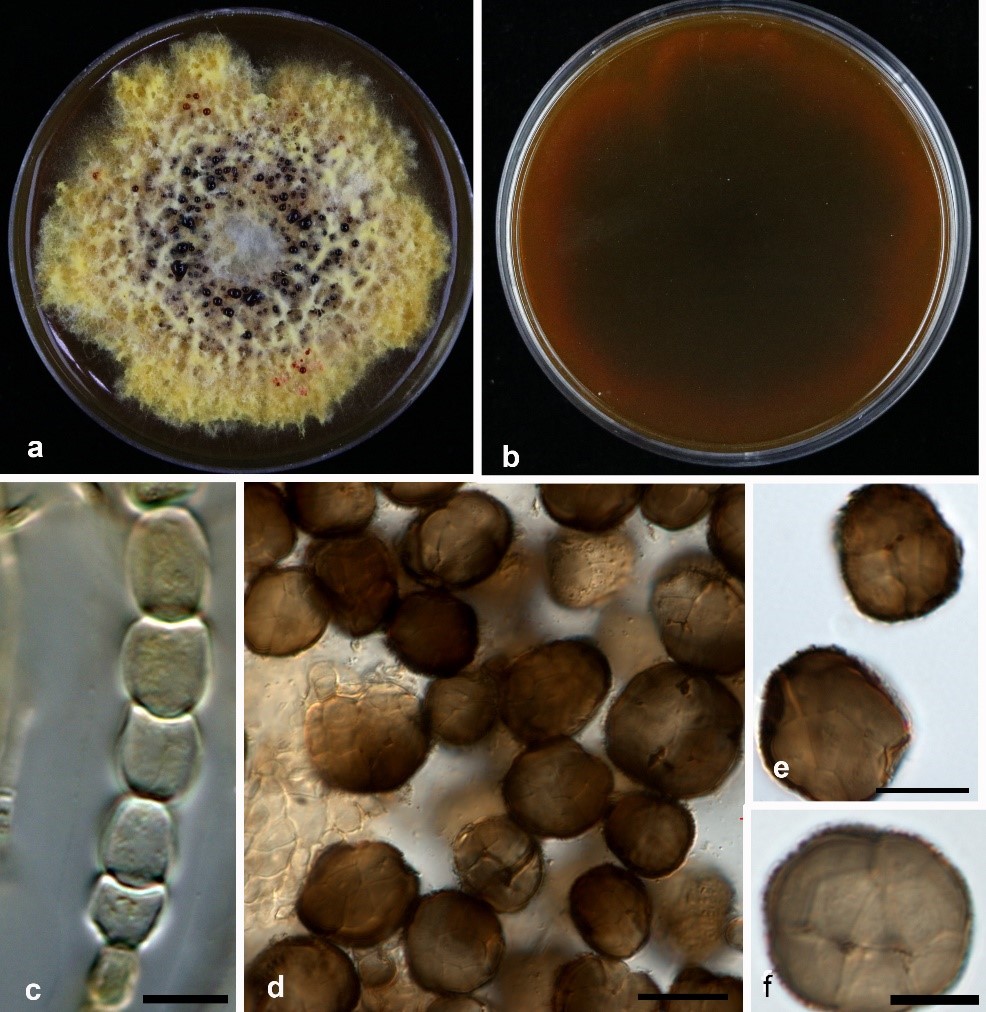Epicoccum henanense W. Zhao, Q. Ning, & J.Y. Yan, sp. nov
MycoBank number: MB 558420; Index Fungorum number: IF 558420; Facesoffungi number: FoF 10793;
Description
Asexual morph: Conidiomata sporodochial, solitary or aggregated, immersed to semi-immersed, glabrous, covered with hyphal growth, blackish brown. Hyphae smooth, branched, septate, hyaline. Chlamydospores multicellular, produced in agar, hyaline to pale brown, subglobose or oblong, 5–10.5×5–8.5 μm(x̅ =7.5×7.3 μm,n = 20). Conidia, multicellular, pale brown to dark brown, globose to subglobose, 17.5–30×13–26 μm(x̅ =21.8×18.7 μm,n = 50). Sexual morph: not observed.
Cultural characteristics – Colonies on PDA are slow-growing, covering a 30 mm Petri dish in 7 days after incubation at 25 ± 1 °C, yellowish, red-white (surface) and reddish-black (reverse), with a dense mat of aerial mycelium, rough, entire slightly radiating at the margin; colony from above, rough, white to reddish at the fruiting zone, slimy reddish spore mass at the centre, whitish, pale yellow at productive and yellowish at ageing zone. Later give reddish-brown colour to the PDA media.
Material examined: China, Henan Province, Shihe District, from Astragalus sinicus pod, May 2018, Zhao Wensheng and Zhang Guozhen (JZBH 380048 holotype), ex-type living culture = JZB 380048.
Additional material examined – China, Henan Province, Shihe District, from Vicia villosa flower, May 2018, Zhao Wensheng and Zhang Guozhen, living culture = JZB 380049, Henan province, Shihe District, from Astragalus sinicus pod, May 2018, Zhao Wensheng and Zhang Guozhen, living culture = JZB 380050.
Distribution: China
Notes: The new strain fit well with the concept of Epicoccum in Didymellaceae. In multi-gene analysis using LSU, ITS, rpb2, and tub markers Epicoccum henanense is sister to E. layuense with 60% ML support (Fig. 5). Epicoccum henanense differs in having relatively larger conidia than E. layuense (17.5–30×13–26 μm vs 13–19.5 μm diam.). Further E. henanense produces globose to subglobose conidia, while E. layuense has subglobose-pyriform conidia. In this study, this new species was isolated from both Astragalus sinicus and Vicia villosa. So far Epicoccum nigrum, was recorded on Vicia villosa from Oregon (Shaw 1973, Farr and Rossman 2022). In China, there are two records of Epicoccum nigrum on Vicia species (Farr and Rossman 2022, Zhuang 2005). Therefore, we herein provide the first record of Epicoccum sp. on Vicia villosa in China.

Fig. x. Epicoccum henanense (JZBH 380048, holotype) a, b Colony on PDA, 10 days after incubation at 25 ± 1 °C (a from above, b from below). c Sporodochia d-f Conidia. Scale bars: c-f= 10 µm.
